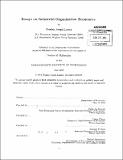| dc.contributor.advisor | Panle Jia Barwick, Glenn Ellison and Stephen P. Ryan. | en_US |
| dc.contributor.author | Larsen, Bradley Joseph | en_US |
| dc.contributor.other | Massachusetts Institute of Technology. Department of Economics. | en_US |
| dc.date.accessioned | 2013-09-24T19:39:11Z | |
| dc.date.available | 2013-09-24T19:39:11Z | |
| dc.date.copyright | 2013 | en_US |
| dc.date.issued | 2013 | en_US |
| dc.identifier.uri | http://hdl.handle.net/1721.1/81045 | |
| dc.description | Thesis (Ph. D.)--Massachusetts Institute of Technology, Dept. of Economics, 2013. | en_US |
| dc.description | Cataloged from PDF version of thesis. | en_US |
| dc.description | Includes bibliographical references (p. 189-201). | en_US |
| dc.description.abstract | The first chapter quantifies the efficiency of a real-world bargaining game with two-sided incomplete information. Myerson and Satterthwaite (1983) and Williams (1987) derived the theoretical efficient frontier for bilateral trade under two-sided uncertainty, but little is known about how well real-world bargaining performs relative to the frontier. The setting is wholesale used-auto auctions, an $80 billion industry where buyers and sellers participate in alternating-offer bargaining when the auction price fails to reach a secret reserve price. Using 300,000 auction/bargaining sequences, this study nonparametrically estimates bounds on the distributions of buyer and seller valuations and then estimates where bargaining outcomes lie relative to the efficient frontier. Findings indicate that the observed auction-followed-by-bargaining mechanism is quite efficient, achieving 88-96% of the surplus and 92-99% of the trade volume which can be achieved on the efficient frontier. This second chapter examines a common form of entry restriction: occupational licensing. The chapter studies how occupational licensing laws affect the distribution of quality and how the effects of licensing on quality vary across regions of differing income levels. The study uses variation in state licensing requirements for teachers and two national datasets on teacher qualifications (input quality) and student test scores (output quality) from 1983-2008. Results show that more restrictive licensing may lead first-year teachers of high input quality to opt out of the occupation. For teachers who remain in the occupation longer, stricter licensing increases input quality at most quantiles. The distribution of student test scores increases with stricter licensing, primarily in the upper half of the distribution. For most forms of licensing studied, input and output quality improvements due to stricter licensing occur in high-income rather than low-income districts. The third chapter (co-authored with Denis Chetverikov and Christopher Palmer) proposes a simple approach for estimating distributional effects of a group-level treatment when there are unobservable components at the group level which may be correlated with the treatment. Standard quantile regression techniques are inconsistent in this setting, while grouped instrumental variables quantile regression is consistent. The study illustrates the estimation approach with several examples, including applications from the first two chapters of this thesis. | en_US |
| dc.description.statementofresponsibility | by Bradley Joseph Larsen. | en_US |
| dc.format.extent | 201 p. | en_US |
| dc.language.iso | eng | en_US |
| dc.publisher | Massachusetts Institute of Technology | en_US |
| dc.rights | M.I.T. theses are protected by
copyright. They may be viewed from this source for any purpose, but
reproduction or distribution in any format is prohibited without written
permission. See provided URL for inquiries about permission. | en_US |
| dc.rights.uri | http://dspace.mit.edu/handle/1721.1/7582 | en_US |
| dc.subject | Economics. | en_US |
| dc.title | Essays on industrial organization economics | en_US |
| dc.type | Thesis | en_US |
| dc.description.degree | Ph.D. | en_US |
| dc.contributor.department | Massachusetts Institute of Technology. Department of Economics | |
| dc.identifier.oclc | 857791462 | en_US |
